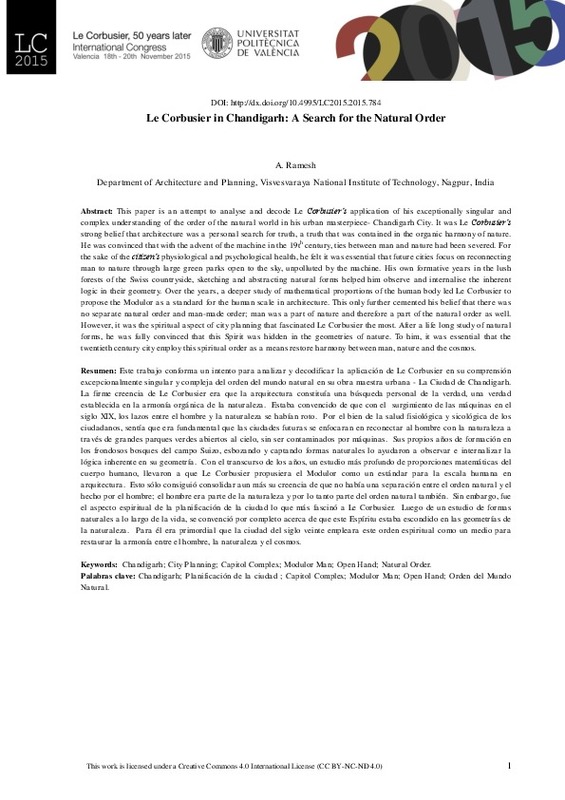JavaScript is disabled for your browser. Some features of this site may not work without it.
Buscar en RiuNet
Listar
Mi cuenta
Estadísticas
Ayuda RiuNet
Admin. UPV
Le Corbusier in Chandigarh: A Search for the Natural Order
Mostrar el registro sencillo del ítem
Ficheros en el ítem
| dc.contributor.author | Ramesh, Aparna
|
es_ES |
| dc.date.accessioned | 2017-09-13T06:34:10Z | |
| dc.date.available | 2017-09-13T06:34:10Z | |
| dc.date.issued | 2016-03-03 | |
| dc.identifier.isbn | 9788490483732 | |
| dc.identifier.uri | http://hdl.handle.net/10251/87136 | |
| dc.description.abstract | [EN] This paper is an attempt to analyse and decode Le Corbusier’s application of his exceptionally singular and complex understanding of the order of the natural world in his urban masterpiece- Chandigarh City. It was Le Corbusier’s strong belief that architecture was a personal search for truth, a truth that was contained in the organic harmony of nature. He was convinced that with the advent of the machine in the 19th century, ties between man and nature had been severed. For the sake of the citizen’s physiological and psychological health, he felt it was essential that future cities focus on reconnecting man to nature through large green parks open to the sky, unpolluted by the machine. His own formative years in the lush forests of the Swiss countryside, sketching and abstracting natural forms helped him observe and internalise the inherent logic in their geometry. Over the years, a deeper study of mathematical proportions of the human body led Le Corbusier to propose the Modulor as a standard for the human scale in architecture. This only further cemented his belief that there was no separate natural order and man-made order; man was a part of nature and therefore a part of the natural order as well. However, it was the spiritual aspect of city planning that fascinated Le Corbusier the most. After a life long study of natural forms, he was fully convinced that this Spirit was hidden in the geometries of nature. To him, it was essential that the twentieth century city employ this spiritual order as a means restore harmony between man, nature and the cosmos | es_ES |
| dc.description.abstract | [ES] Este trabajo conforma un intento para analizar y decodificar la aplicación de Le Corbusier en su comprensión excepcionalmente singular y compleja del orden del mundo natural en su obra maestra urbana - La Ciudad de Chandigarh. La firme creencia de Le Corbusier era que la arquitectura constituía una búsqueda personal de la verdad, una verdad establecida en la armonía orgánica de la naturaleza. Estaba convencido de que con el surgimiento de las máquinas en el siglo XIX, los lazos entre el hombre y la naturaleza se habían roto. Por el bien de la salud fisiológica y sicológica de los ciudadanos, sentía que era fundamental que las ciudades futuras se enfocaran en reconectar al hombre con la naturaleza a través de grandes parques verdes abiertos al cielo, sin ser contaminados por máquinas. Sus propios años de formación en los frondosos bosques del campo Suizo, esbozando y captando formas naturales lo ayudaron a observar e internalizar la lógica inherente en su geometría. Con el transcurso de los años, un estudio más profundo de proporciones matemáticas del cuerpo humano, llevaron a que Le Corbusier propusiera el Modulor como un estándar para la escala humana en arquitectura. Esto sólo consiguió consolidar aun más su creencia de que no había una separación entre el orden natural y el hecho por el hombre; el hombre era parte de la naturaleza y por lo tanto parte del orden natural también. Sin embargo, fue el aspecto espiritual de la planificación de la ciudad lo que más fascinó a Le Corbusier. Luego de un estudio de formas naturales a lo largo de la vida, se convenció por completo acerca de que este Espíritu estaba escondido en las geometrías de la naturaleza. Para él era primordial que la ciudad del siglo veinte empleara este orden espiritual como un medio para restaurar la armonía entre el hombre, la naturaleza y el cosmos. | es_ES |
| dc.format.extent | 14 | es_ES |
| dc.language | Inglés | es_ES |
| dc.publisher | Editorial Universitat Politècnica de València | es_ES |
| dc.relation.ispartof | LE CORBUSIER. 50 AÑOS DESPUÉS | es_ES |
| dc.rights | Reconocimiento - No comercial - Sin obra derivada (by-nc-nd) | es_ES |
| dc.subject | architecture | es_ES |
| dc.subject | le corbusier | es_ES |
| dc.subject | modern movement | es_ES |
| dc.title | Le Corbusier in Chandigarh: A Search for the Natural Order | es_ES |
| dc.type | Capítulo de libro | es_ES |
| dc.type | Comunicación en congreso | es_ES |
| dc.identifier.doi | 10.4995/LC2015.2015.784 | |
| dc.rights.accessRights | Abierto | es_ES |
| dc.description.bibliographicCitation | Ramesh, A. (2016). Le Corbusier in Chandigarh: A Search for the Natural Order. En LE CORBUSIER. 50 AÑOS DESPUÉS. Editorial Universitat Politècnica de València. 1784-1797. https://doi.org/10.4995/LC2015.2015.784 | es_ES |
| dc.description.accrualMethod | OCS | es_ES |
| dc.relation.conferencename | LC2015 - Le Corbusier, 50 years later | es_ES |
| dc.relation.conferencedate | November 18-20,2015 | es_ES |
| dc.relation.conferenceplace | Valencia, Spain | es_ES |
| dc.relation.publisherversion | http://ocs.editorial.upv.es/index.php/LC2015/LC2015/paper/view/784 | es_ES |
| dc.description.upvformatpinicio | 1784 | es_ES |
| dc.description.upvformatpfin | 1797 | es_ES |
| dc.type.version | info:eu-repo/semantics/publishedVersion | es_ES |
| dc.relation.pasarela | OCS\784 | es_ES |








